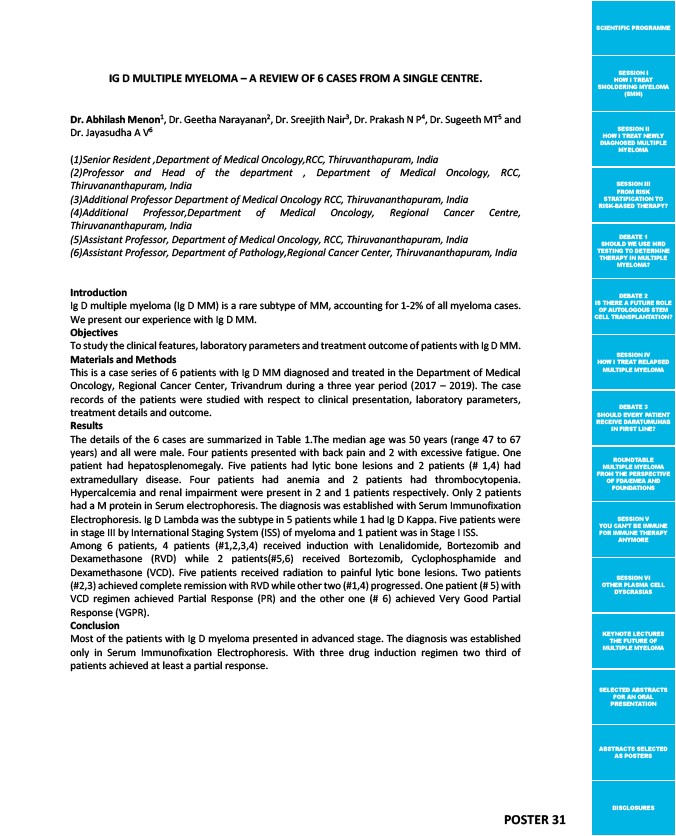
SCIENTIFIC PROGRAMME
SESSION I
HOW I TREAT
SMOLDERING MYELOMA
(SMM)
SESSION II
HOW I TREAT NEWLY
DIAGNOSED MULTIPLE
MYELOMA
SESSION III
FROM RISK
STRATIFICATION TO
RISK-BASED THERAPY?
DEBATE 1
SHOULD WE USE MRD
TESTING TO DETERMINE
THERAPY IN MULTIPLE
MYELOMA?
DEBATE 2
IS THERE A FUTURE ROLE
OF AUTOLOGOUS STEM
CELL TRANSPLANTATION?
SESSION IV
HOW I TREAT RELAPSED
MULTIPLE MYELOMA
DEBATE 3
SHOULD EVERY PATIENT
RECEIVE DARATUMUMAB
IN FIRST LINE?
ROUNDTABLE
MULTIPLE MYELOMA
FROM THE PERSPECTIVE
OF FDA/EMEA AND
FOUNDATIONS
SESSION V
YOU CAN’T BE IMMUNE
FOR IMMUNE THERAPY
ANYMORE
SESSION VI
OTHER PLASMA CELL
DYSCRASIAS
KEYNOTE LECTURES
THE FUTURE OF
MULTIPLE MYELOMA
SELECTED ABSTRACTS
FOR AN ORAL
PRESENTATION
ABSTRACTS SELECTED
AS POSTERS
DISCLOSURES
POSTER 31
IG D MULTIPLE MYELOMA – A REVIEW OF 6 CASES FROM A SINGLE CENTRE.
Dr. Abhilash Menon1, Dr. Geetha Narayanan2, Dr. Sreejith Nair3, Dr. Prakash N P4, Dr. Sugeeth MT5 and
Dr. Jayasudha A V6
(1)Senior Resident ,Department of Medical Oncology,RCC, Thiruvanthapuram, India
(2)Professor and Head of the department , Department of Medical Oncology, RCC,
Thiruvananthapuram, India
(3)Additional Professor Department of Medical Oncology RCC, Thiruvananthapuram, India
(4)Additional Professor,Department of Medical Oncology, Regional Cancer Centre,
Thiruvananthapuram, India
(5)Assistant Professor, Department of Medical Oncology, RCC, Thiruvananthapuram, India
(6)Assistant Professor, Department of Pathology,Regional Cancer Center, Thiruvananthapuram, India
Introduction
Ig D multiple myeloma (Ig D MM) is a rare subtype of MM, accounting for 1-2% of all myeloma cases.
We present our experience with Ig D MM.
Objectives
To study the clinical features, laboratory parameters and treatment outcome of patients with Ig D MM.
Materials and Methods
This is a case series of 6 patients with Ig D MM diagnosed and treated in the Department of Medical
Oncology, Regional Cancer Center, Trivandrum during a three year period (2017 – 2019). The case
records of the patients were studied with respect to clinical presentation, laboratory parameters,
treatment details and outcome.
Results
The details of the 6 cases are summarized in Table 1.The median age was 50 years (range 47 to 67
years) and all were male. Four patients presented with back pain and 2 with excessive fatigue. One
patient had hepatosplenomegaly. Five patients had lytic bone lesions and 2 patients (# 1,4) had
extramedullary disease. Four patients had anemia and 2 patients had thrombocytopenia.
Hypercalcemia and renal impairment were present in 2 and 1 patients respectively. Only 2 patients
had a M protein in Serum electrophoresis. The diagnosis was established with Serum Immunofixation
Electrophoresis. Ig D Lambda was the subtype in 5 patients while 1 had Ig D Kappa. Five patients were
in stage III by International Staging System (ISS) of myeloma and 1 patient was in Stage I ISS.
Among 6 patients, 4 patients (#1,2,3,4) received induction with Lenalidomide, Bortezomib and
Dexamethasone (RVD) while 2 patients(#5,6) received Bortezomib, Cyclophosphamide and
Dexamethasone (VCD). Five patients received radiation to painful lytic bone lesions. Two patients
(#2,3) achieved complete remission with RVD while other two (#1,4) progressed. One patient (# 5) with
VCD regimen achieved Partial Response (PR) and the other one (# 6) achieved Very Good Partial
Response (VGPR).
Conclusion
Most of the patients with Ig D myeloma presented in advanced stage. The diagnosis was established
only in Serum Immunofixation Electrophoresis. With three drug induction regimen two third of
patients achieved at least a partial response.